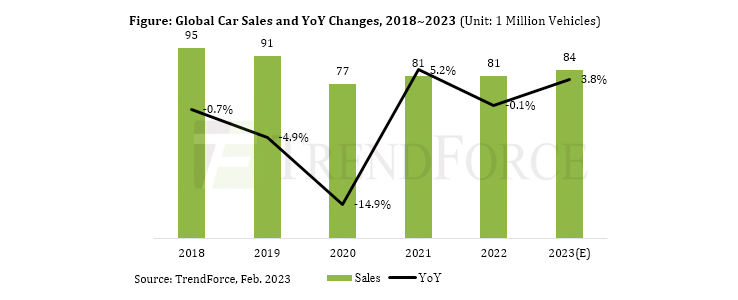However, there is a chance that the global car market will return to positive growth this year. TrendForce currently forecasts global car sales to grow 3.8% year-on-year to 84.1 million vehicle units by 2023.
Data from TrendForce reveals that car sales in China will reach 26.9 million vehicle units in 2022, reflecting year-on-year growth of 3.7%. Demand from China has been the key pillar supporting the entire global new car market. By contrast, annual US and Western European auto sales figures hit a decade low by 2022. The US recorded just 13.7 million vehicle units, reflecting a decline year-on-year of 8.1%. Western Europe recorded just 11.8 million vehicle units, reflecting a year-on-year decline of 4.6%. Eastern Europe’s new car market also saw a 27.3% year-on-year drop to 2022. Due to the impact of its military conflict with Ukraine, Russia saw a contraction of one million of vehicle units in new car sales compared to 2021. In emerging markets, their performance was relatively strong in 2022. With an annual sales figure of 4.3 million vehicle units, the India overtook Japan to become the world’s third largest car market for the first time. Likewise, car sales in Indonesia recorded positive growth for the second consecutive year and returned to pre-pandemic levels.
| region | 2021 | 2022 |
| china | 32.0% | 33.2% |
| WE | 18.4% | 17.0% |
| Japan | 5.4% | 5.1% |
| India | 4.4% | 5.4% |
| western europe | 15.2% | 14.5% |
| Eastern Europe | 5.0% | 3.6% |
| others | 19.6 | 21.2% |
| total | 100.0% | 100.0% |
TrendForce notes that automakers still have a certain amount of unfilled vehicle orders that have been carried over from last year. Therefore, part of the expected sales growth for 2023 will be attributed to this demand. By region, China’s new car market will show small or flat year-on-year growth to 2023, mainly due to the change in vehicle purchase tax on fossil fuel-powered cars. This tax was halved last year, encouraging Chinese consumers to buy new cars early. Consequently, car sales in this country cannot be easily increased this year. A stronger policy incentive may be needed to effectively stimulate demand.
As for the US, there is potential for growth in 2023 because its sales figure for 2022 is a low comparison base. In addition, there are signs that consumer confidence has returned to this country. On the other hand, the average price of new cars in the US has risen sharply, and recent interest rate hikes have created an unfavorable situation for people looking to get auto loans. The effects of these trends on the US auto market cannot be ignored. As for Western Europe, its sales figure for 2022 is also a low base of comparison. However, the military conflict between Russia and Ukraine continues and the challenges associated with energy shortages across the region remain unresolved. These factors will influence the growth of the Western Europe market during 2023.
For more information, visit TrendForce.


